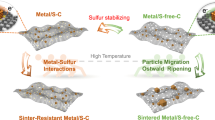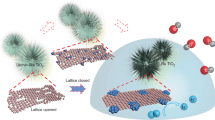Abstract
The generation of methane fuel using surplus renewable energy with CO2 as the carbon source enables both the decarbonization and substitution of fossil fuel feedstocks. However, high temperatures are usually required for the efficient activation of CO2. Here we present a solid catalyst synthesized using a mild, green hydrothermal synthesis that involves interstitial carbon doped into ruthenium oxide, which enables the stabilization of Ru cations in a low oxidation state and a ruthenium oxycarbonate phase to form. The catalyst shows an activity and selectivity for the conversion of CO2 into methane at lower temperatures than those of conventional catalysts, with an excellent long-term stability. Furthermore, this catalyst is able to operate under intermittent power supply conditions, which couples very well with electricity production systems based on renewable energies. The structure of the catalyst and the nature of the ruthenium species were acutely characterized by combining advanced imaging and spectroscopic tools at the macro and atomic scales, which highlighted the low-oxidation-state Ru sites (Run+, 0 < n < 4) as responsible for the high catalytic activity. This catalyst suggests alternative perspectives for materials design using interstitial dopants.
This is a preview of subscription content, access via your institution
Access options
Access Nature and 54 other Nature Portfolio journals
Get Nature+, our best-value online-access subscription
$29.99 / 30 days
cancel any time
Subscribe to this journal
Receive 12 print issues and online access
$259.00 per year
only $21.58 per issue
Buy this article
- Purchase on Springer Link
- Instant access to full article PDF
Prices may be subject to local taxes which are calculated during checkout






Similar content being viewed by others
Data availability
The authors declare that the main data supporting the findings of this study are available within the article and its Supplementary Information files. Crystallographic data for the structure reported in this article have been deposited at the Cambridge Crystallographic Data Centre, under deposition number CCDC 2248295. Copies of the data can be obtained free of charge via https://www.ccdc.cam.ac.uk/structures/. Ru and RuO2 structures for analysis were taken from ICSD entries 44615 and 15071, respectively. Extra data are available from the corresponding author upon request.
References
Gary Grim, R. et al. Transforming the carbon economy: challenges and opportunities in the convergence of low-cost electricity and reductive CO2 utilization. Energy Environ. Sci. 13, 472–494 (2020).
Ghaib, K. & Ben-Fares, F. Z. Power-to-methane: a state-of-the-art review. Renew. Sust. Energy Rev. 81, 433–446 (2018).
Eveloy, V. & Gebreegziabher, T. A review of projected power-to-gas deployment scenarios. Energies 11, 1824 (2018).
Cored, J. et al. Hydrothermal synthesis of ruthenium nanoparticles with a metallic core and a ruthenium carbide shell for low-temperature activation of CO2 to methane. J. Am. Chem. Soc. 141, 19304 (2019).
Yan, C. et al. Local built-in electric field enabled in carbon-doped Co3O4 nanocrystals for superior lithium-ion storage. Adv. Funct. Mater. 28, 1705951 (2018).
Ruan, F. et al. Enhanced activity for aerobic oxidative of alcohols over manganese oxides stimulated with interstitial nitrogen doping. Green. Synth. Catal. 2, 38–44 (2021).
Aroyo, M. I. et al. Crystallography online: Bilbao Crystallographic Server. Bulg. Chem. Commun. 43, 183–197 (2011).
Rutt, H. N. & Nicola, J. H. Raman spectra of carbonates of calcite structure. J. Phys. C 7, 4522–4528 (1974).
Buzgar, N. & Apopei, A. I. The Raman study of certain carbonates. Geologie 55, 97–112 (2009).
Planas, N. et al. Electronic structure of oxidized complexes derived from cis-[Ru-II(bpy) 2(H2 O)2]2+ and its photoisomerization mechanism. Inorg. Chem. 50, 11134–11142 (2011).
Zhao, Z. et al. Effect of rutile content on the catalytic performance of Ru/TiO2 catalyst for low-temperature CO2 methanation. ACS Sustain. Chem. Eng. 9, 14288–14296 (2021).
Lippi, R. et al. Highly active catalyst for CO2 methanation derived from a metal organic framework template. J. Mater. Chem. A 5, 12990–12997 (2017).
Li, X. et al. Controlling CO2 hydrogenation selectivity by metal-supported electron transfer. Angew. Chem. Int. Ed. 59, 19983–19989 (2020).
Renda, S., Ricca, A. & Palma, V. Precursor salts influence in ruthenium catalysts for CO2 hydrogenation to methane. Appl. Energy 279, 115767 (2020).
Liao, W. et al. Tuning activity and selectivity of CO2 hydrogenation via metal–oxide interfaces over ZnO-supported metal catalysts. J. Catal. 407, 126–140 (2022).
Niu, Y. et al. Manipulating interstitial carbon atoms in the nickel octahedral site for highly efficient hydrogenation of alkyne. Nat. Commun. 11, 3324 (2020).
Tanuma, S., Powell, C. J. & Penn, D. R. Calculations of electron inelastic mean free paths. V. Data for 14 organic compounds over the 50–2000 eV range. Surf. Interf. Anal. 21, 165–176 (1994).
Shinotsuka, H., Tanuma, S., Powell, C. J. & Penn, D. R. Calculations of electron inelastic mean free paths. X. Data for 41 elemental solids over the 50 eV to 200 keV range with the relativistic full Penn algorithm. Surf. Interf. Anal. 47, 871–888 (2015).
Morgan, D. J. Resolving ruthenium: XPS studies of common ruthenium materials. Surf. Interf. Anal. 47, 1072–1079 (2015).
Yeh, J. J. & Lindau, I. Atomic subshell photoionization cross-sections and asymmetry parameters: 1 ≤ Z ≤ 103. Atomic Data Nucl. Data Tables 32, 1–155 (1985).
Simonelli, L. et al. CLÆSS: The hard X-ray absorption beamline of the ALBA CELLS synchrotron. Cogent Phys. 3, 1231987 (2016).
Ravel, B. & Newville, M. ATHENA, ARTEMIS, HEPHAESTUS: data analysis for X-ray absorption spectroscopy using IFEFFIT. J. Synchrotron Radiat. 12, 537–541 (2005).
Newville, M. EXAFS analysis using FEFF and FEFFIT. J. Synchrotron Radiat. 8, 96–100 (2001).
Rehr, J. J. & Albers, R. C. Theoretical approaches to X-ray absorption fine structure. Rev. Mod. Phys. 72, 621–654 (2000).
Robinson, D. K. & Bevington, P. R. Sample Programs for Data Reduction and Error Analysis for the Physical Sciences (McGraw-Hill, 1992).
Newville, M. Larch: an analysis package for XAFS and related spectroscopies. J. Phys. Conf. Ser. 430, 012007 (2013).
Faut, F. et al. The crystallography stations at the Alba synchrotron. Eur. Phys. J. 130, 160–173 (2015).
Favre-Nicolin, V. & Cerny, R. FOX, ‘free objects for crystallography’: a modular approach to ab initio structure determination from powder diffraction. J. Appl. Cryst. 35, 734–743 (2002).
Toby, B. & von Dreele, R. B. GSAS-II: the genesis of a modern open-source all purpose crystallography software package. J. Appl. Crystallogr. 46, 544–549 (2013).
Roy, P., Rouzières, M., Qi, Z. & Chubar, O. The AILES Infrared Beamline on the third generation Synchrotron Radiation Facility SOLEIL. Infrared Phys. Technol. 49, 139–146 (2006).
Faye, M. et al. Improved mid infrared detector for high spectral or spatial resolution and synchrotron radiation use. Rev. Sci. Instrum. 87, 063119 (2016).
Acknowledgements
We thank the support of C. Cerdá and M. D. Soriano in the catalyst preparation and testing. This research was funded by the Ministerio de Ciencia, Innovación y Universidades (grant nos. PID2021-1262350B-C31, PID2020-113006-RB-I00, PID2019-110018GA-I00 and MCIN/AEI/10.13039/501100011033), Generalitat Valenciana (grant no. CIAICO/2021/2138), the Department of Economy, Knowledge, Business and the University of the Regional Government of Andalusia (project reference FEDER-UCA18-107139). This study forms part of the Advanced Materials programme and was supported by MCIN with funding from the European Union Next Generation (EU PRTR-C17.11) and by Generalitad Valenciana (ref. MFA/2022/016). C.T.-S. acknowledges the Polytechnical University of Valencia for the economic support through an FPI scholarship associated with the PAID programme ‘Programa de Ayudas de Investigación y Desarrollo’. XAS, XPS and XRD experiments were performed at the ALBA Synchrotron with the collaboration of ALBA staff. Infrared experiments were performed at the SOLEIL Synchrotron with the collaboration of SOLEIL staff.
Author information
Authors and Affiliations
Contributions
P.C. and A.C. planned the study and obtained the financial support. C.T.-S. did the synthesis and catalytic studies assisted by P.C. and A.C. V.M.-D. and L.S. performed the X-ray adsorption studies. A.M. did the SXRD analysis. I.V.-G. and V.P.-D. gave support in the synchrotron XPS analysis. C.T.-S. and J.-B.B. performed the synchrotron infrared studies assisted by R.P. M.L.H. and J.J.C. did the microscopy work. P.C., A.C. and C.T.-S. wrote the paper with the input from all the authors. All the authors contributed to discussing the results.
Corresponding authors
Ethics declarations
Competing interests
The authors declare no competing interests.
Peer review
Peer review information
Nature Materials thanks Bruce Gates and the other, anonymous, reviewer(s) for their contribution to the peer review of this work.
Additional information
Publisher’s note Springer Nature remains neutral with regard to jurisdictional claims in published maps and institutional affiliations.
Supplementary information
Supplementary Information
Supplementary Figs. 1–42, Tables 1–15 and references 32–70.
Supplementary Data
Structure refinement of the fresh RuO2C0.41 catalyst.
Rights and permissions
Springer Nature or its licensor (e.g. a society or other partner) holds exclusive rights to this article under a publishing agreement with the author(s) or other rightsholder(s); author self-archiving of the accepted manuscript version of this article is solely governed by the terms of such publishing agreement and applicable law.
About this article
Cite this article
Tébar-Soler, C., Martin-Diaconescu, V., Simonelli, L. et al. Low-oxidation-state Ru sites stabilized in carbon-doped RuO2 with low-temperature CO2 activation to yield methane. Nat. Mater. 22, 762–768 (2023). https://doi.org/10.1038/s41563-023-01540-1
Received:
Accepted:
Published:
Issue Date:
DOI: https://doi.org/10.1038/s41563-023-01540-1
This article is cited by
-
A catalyst for low-temperature CO2 activation
Nature Materials (2023)



